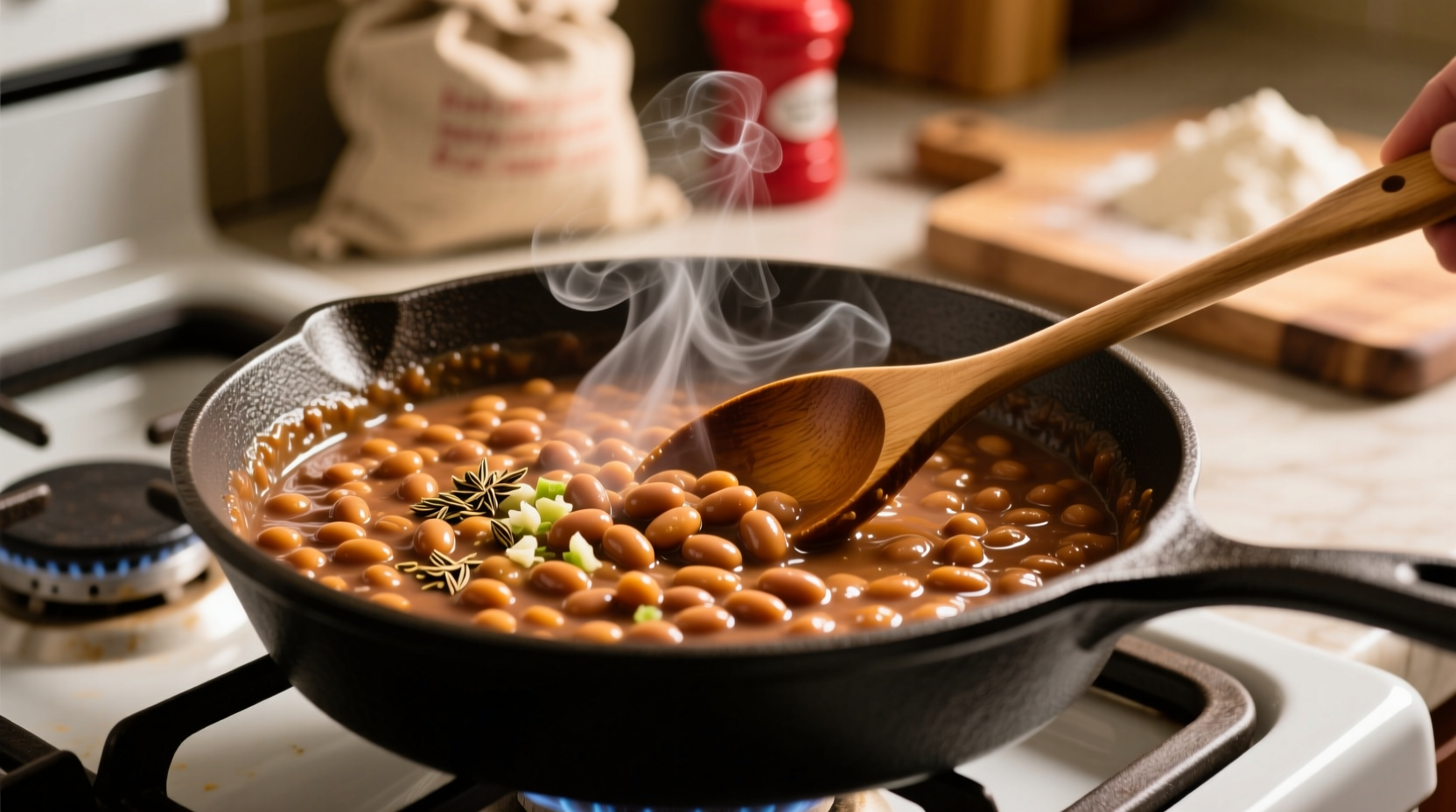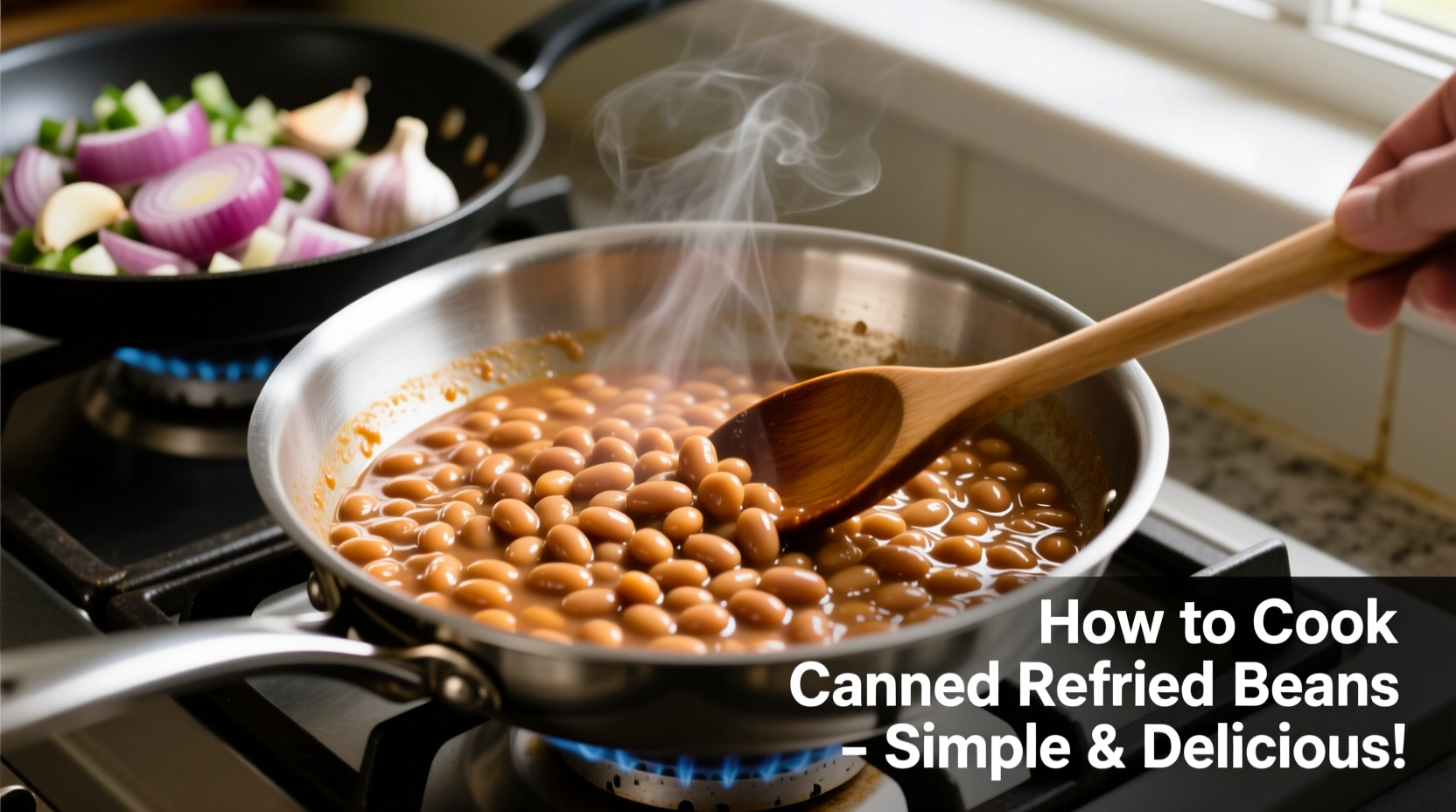Refried beans are a staple in Mexican and Latin American cuisine, offering protein-rich comfort in minutes. While convenient, many home cooks struggle with achieving the perfect texture and flavor from canned varieties. This guide reveals professional techniques to elevate your canned refried beans from basic to exceptional, with insights from culinary experts who understand traditional preparation methods.
Why Canned Refried Beans Need Proper Preparation
Canned refried beans contain preservatives and often have a dense, pasty texture straight from the container. Proper heating technique restores their creamy consistency while enhancing natural flavors. According to the USDA Food Safety and Inspection Service, beans should reach an internal temperature of 165°F (74°C) for safe consumption, which proper heating ensures.
| Preparation Method | Texture Result | Flavor Development | Time Required |
|---|---|---|---|
| Heated straight from can | Dense, uneven | Flat, metallic notes | 3 minutes |
| Stovetop with liquid | Creamy, smooth | Rich, balanced | 7 minutes |
| Slow cooker method | Ultra-creamy | Deep, complex | 30 minutes |
Essential Equipment and Ingredients
You'll need just a few basic items:
- Medium saucepan with heavy bottom (prevents scorching)
- Whisk or sturdy spoon
- Measuring spoons
- Canned refried beans (traditional pinto or black bean varieties)
- Liquid for thinning (water, broth, or milk)

Step-by-Step Cooking Method
1. Prepare Your Workspace
Gather ingredients and tools before starting. Canned refried beans heat quickly, so having everything ready prevents burning. Open the can and transfer contents to your saucepan—don't rinse, as this removes valuable flavor compounds.
2. Add Liquid Strategically
Start with 2 tablespoons of liquid per can. Water works fine, but chicken or vegetable broth adds depth, while milk creates exceptional creaminess. Professional chefs recommend warming the liquid first to prevent temperature shock that can cause separation.
3. Heat Gently with Constant Stirring
Set burner to medium-low heat—never high. Stir continuously in a figure-eight pattern, scraping the bottom thoroughly. This technique, used in authentic Mexican kitchens, prevents scorching while incorporating air for lighter texture. After 3 minutes, check consistency and add more liquid if needed.
4. Enhance Flavor Profile
After 5 minutes of heating, incorporate flavor boosters:
- 1 teaspoon lime juice for brightness
- 1/4 teaspoon cumin for earthiness
- 1 minced garlic clove (sautéed separately first)
- Chopped cilantro for freshness
Avoiding Common Mistakes
Many home cooks encounter these issues when preparing canned refried beans:
- Burning: Caused by high heat or infrequent stirring. Always use medium-low heat and stir constantly.
- Watery consistency: Adding too much liquid at once. Add incrementally until desired thickness.
- Flat flavor: Skipping the flavor enhancement step. Even simple additions transform canned beans.
Context-Specific Techniques
Different serving scenarios require tailored approaches:
- For restaurant-style presentation: Heat with chicken broth and finish with a pat of butter for glossy texture.
- When making bean dip: Add 1/4 cup shredded cheese during final minute of heating.
- For dietary restrictions: Use vegetable broth and omit dairy for vegan version.
Serving and Storage Tips
Serve immediately for best texture. Keep warm over lowest heat setting if needed, stirring occasionally. Leftovers store well in airtight container for 3-4 days. When reheating, add small amounts of liquid to restore creaminess. Never microwave without covering, as this causes uneven heating and texture issues.
Transforming Basic Canned Beans
Professional chefs use these advanced techniques to make canned refried beans taste homemade:
- Layered seasoning: Add half your spices at beginning, half at end for complex flavor development
- Temperature control: Keep below simmer point (185°F/85°C) to maintain creamy emulsion
- Resting period: Let sit covered for 2 minutes after heating for optimal texture
Frequently Asked Questions
Can you cook refried beans directly from the can without adding liquid?
While possible, cooking refried beans without added liquid typically results in burning and uneven heating. The USDA recommends adding liquid to ensure even heating to the safe temperature of 165°F throughout. For best texture and flavor, always incorporate 2-4 tablespoons of liquid per can.
How long should you heat canned refried beans?
Heat canned refried beans for 5-10 minutes over medium-low heat while stirring constantly. This ensures they reach the safe internal temperature of 165°F while developing optimal creamy texture. Heating longer than 10 minutes without additional liquid may cause burning.
What's the best liquid to add to canned refried beans?
The best liquid depends on your desired flavor profile. Water works for basic preparation, chicken or vegetable broth adds depth, and milk creates exceptional creaminess. Traditional Mexican preparation often uses reserved bean cooking liquid, but for canned beans, warmed broth provides the most authentic flavor enhancement.
Why do my refried beans keep sticking to the pan?
Refried beans stick when heat is too high or stirring is infrequent. Use medium-low heat and stir constantly in a figure-eight pattern, scraping the bottom thoroughly. A heavy-bottomed saucepan prevents hot spots. If sticking occurs, immediately remove from heat and add small amounts of liquid while stirring to release any stuck particles.











 浙公网安备
33010002000092号
浙公网安备
33010002000092号 浙B2-20120091-4
浙B2-20120091-4